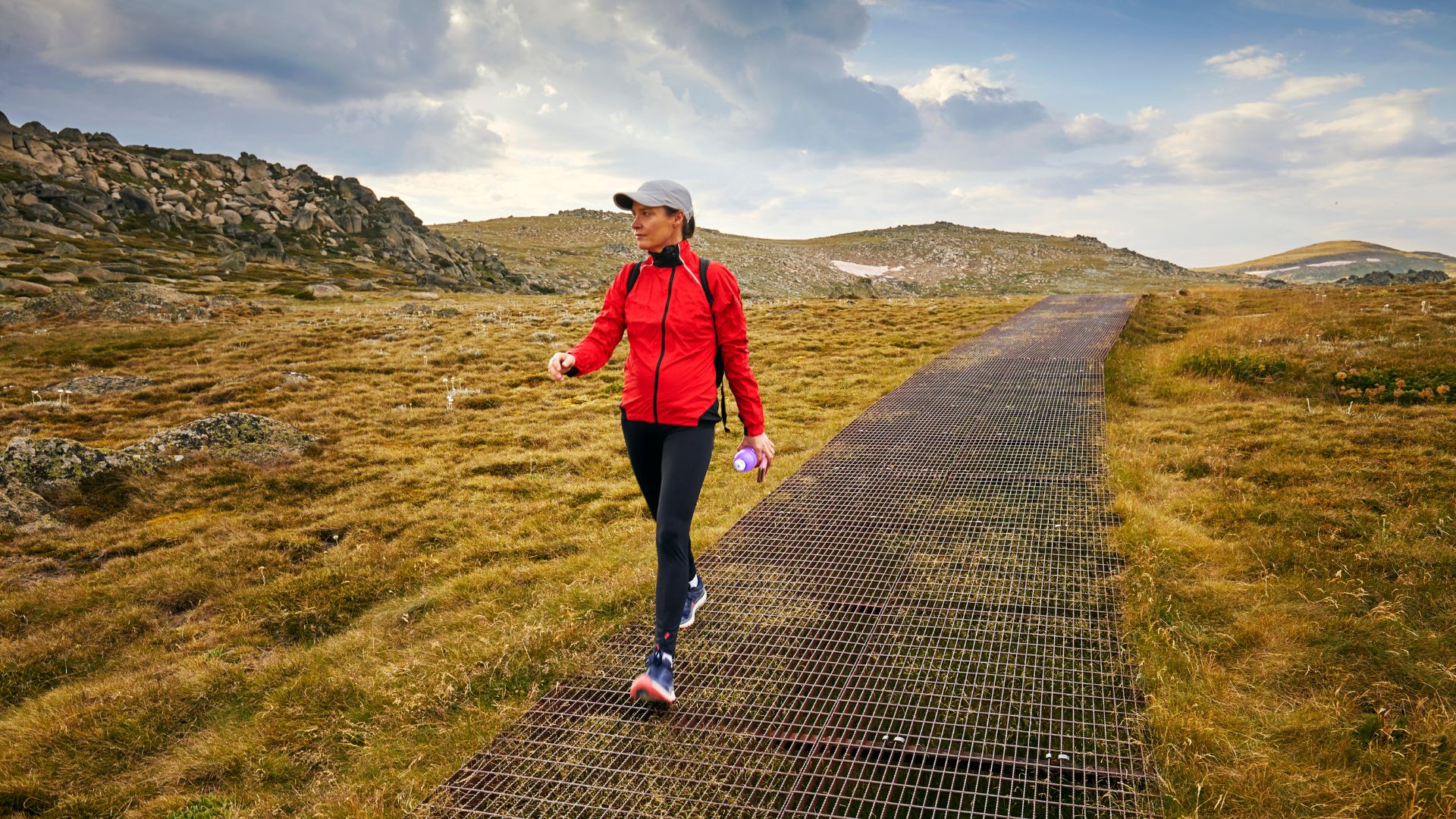What is walking meditation? Experts explain how to get the most out of this stress-busting exercise
Walking meditation has so many benefits. Here, two experts explain what it is and how to do it


We know that sitting meditation and mindfulness can do wonders for our health but what about walking meditation? While the practice has been around for thousands of years, only recently have scientists truly been able to understand why it's so good for us.
As the name suggests, walking meditation is meditation in motion. Instead of sitting or standing quietly, eyes closed, this particular type of mindfulness involves moving the body and taking in the fresh air.
Even as recently as August 2022, scientists have been offering us new information about meditation, soft hiking, and all the many benefits of walking. To explain how to get the most out of your session, before you pick up your walking shoes, woman&home speaks to a doctor specializing in outdoor therapy and a meditation teacher.
What is walking meditation?
It’s purposeful meditation that we do while walking, explains qualified psychotherapist and meditation teacher Jacqueline Carson. “The aim is to align the body and the mind together. During sitting meditation, we focus on breathing to bring us back from our intrusive thoughts. In walking meditation, we focus on the movement of the body and the steps in particular.”
What makes walking meditation and regular walking different though? “We walk with our minds open mindfully,” Carson says. “We are observant of our surroundings but focused on our physical body. Depending on where you are walking, notice the sounds of birds or cars passing but without thinking about them. You’re not following the sounds, just observing.”

How to try walking meditation for the first time
1. Choose your location carefully
Just as you might not practice sitting meditation around others if you find it distracting, having the right surroundings for your walking meditation session is essential. As it’s walking, you’ll also want to take a look at the location in particular detail and consider stocking up on hiking essentials, like the best hiking boots, if needed.
“If you are going out into the countryside, make sure you are on level ground with no steep hills. Stick to footpaths and avoid walking through livestock. Although you can do walking meditation in towns and cities, finding somewhere quiet and peaceful is best so that you have fewer distractions and a quieter, more relaxing environment.”
Sign up for the woman&home newsletter
Sign up to our free daily email for the latest royal and entertainment news, interesting opinion, expert advice on styling and beauty trends, and no-nonsense guides to the health and wellness questions you want answered.
2. Take your time
Walking meditation doesn’t have a purpose in the same way that walking to build muscle does - so take your time and enjoy the process. There’s no need to set a demanding pace or try and cover a certain number of miles, says the meditation teacher.
“Remember there are no rules. You can’t get this wrong, so just relax. And anytime you feel distracted, know that this is your mind interfering, telling you that you don’t have time to meditate. Ignore those thoughts and refocus on the sensations in your body.”
3. Focus on your breathing
Breathing is a mostly unconscious process but it has a huge impact on the chemical and physiological activities in the body, says Dr Suzanne Hackenmiller, a specialist in outdoor therapy and integrative medicine. “Exploring breathing practices in nature provides for a unique environment in which we can achieve better mental and physical health,” she explains.
For example, “one of the simplest methods for inducing the body’s relaxation response is to prolong the exhale or the ‘outbreath’. By breathing in for a count of six or eight, we can reverse the body’s stress response in a matter of seconds,” says Dr Hackenmiller, who is also the chief medical officer for AllTrails.
4. Walk at a steady pace
This isn't running meditation. Walking meditation is supposed to be relaxing, so you’ll want to keep a steady pace still. “We want to be walking at a rhythmic pace and to be aware of this. We want to notice the feeling of the ground underneath our feet,” says Carson.
To increase this grounded feeling, she also suggests walking barefoot where possible. “This will bring added benefits of grounding to the earth and connecting to nature. Imagine that your feet are rooted into the earth and feel the strong foundations like the roots of a tree. Imagine the nourishment, the strength. Feel the texture of the ground. Is it hard or soft? Wet or dry? The temperature, is it warm or cool?”
5. Focus on how you feel
If you’ve followed a session from one of the best mindfulness apps, this won’t be new to you. When trying walking meditation for the first time, think about how it feels. “Consider what sensations you can feel, the temperature of the air on your skin, and any tension or tightness in the body," says Carson.
When you're finished with your walks, you could always log your feelings in a diary or one of the best journaling apps.
6. Do not attach meanings to sounds
If you’re hearing birds chirping, cars going by, or snippets of conversation from other walkers, try to detach from creating meaning or story to those sounds, Carson suggests. This will be the ultimate distraction and sure to bring you out of your meditative mindset.
“Similarly with smells, notice any smells but don’t attach any meaning to them. Take note of how your mind might want to do this. When this happens, bring your attention back to your body, to the movement and rhythm of your body. Notice where you place your feet, and how your arms swing or not by your side.”
And similarly, try to avoid any chance of distraction by turning off any devices. “The idea is that you’re going off the grid for a while, even if it’s only for ten minutes,” she adds.
7. Be consistent
If you’ve tried walking meditation once and struggled to get into the flow, try it a few more times. Consistency is key, says Carson. “The more you practice, the easier it will become and the more you will reap the benefits. That said, even if you can only practice once a week, do that.”

Does walking meditation reduce stress?
Walking is good exercise but this is walking meditation’s biggest benefit and there’s plenty of research out there, including a review by the University of Pennslyvania, to back up the science. “It has been shown to lower salivary cortisol and amylase levels since it lowers the stress response,” explains Dr Hackenmiller.
Carson adds, “When we are rushing about and multi-tasking, feeling stressed and overwhelmed, we are flooding our body with stress hormones, making us feel anxious and putting us at risk of mental and physical illness. A consistent meditation practice helps to promote an overall sense of calmness which improves our physical and emotional wellbeing.”
Walking and staying mindful, whether it's a casual stroll or Nordic walking, not only helps us deal with stress that walking works wonders for though, explains Dr Hackenmiller. “The ancient sages meditated in nature thousands of years ago,” she says. “Spending any time in nature has shown improved mental health for those experiencing depression and anxiety, and it’s also been proven to boost self-esteem. Physically, guided meditation in nature is also able to lower blood pressure and heart rate and improve heart rate variability.”
Benefits of walking meditation
- You can do it for however long you like: While walking meditation has all these benefits, there’s no need to spend hours doing it. “There’s no set prescription for when and how much time you should spend walking in nature, as even short periods spent outdoors have immediate benefits,” Dr Hackenmiller says.
- It helps the immune system to function properly: It’s a fact that spending more time in nature boosts your immune system, the doctor confirms. “Not only are we afforded safe exposure to the sun’s vitamin D, but by inhaling the immune-boosting phytoncides emitted by trees and plants and experiencing the surrounding beauty, our natural killer cell number, and activity increase, which helps boost the immune system.”
- You can do it anywhere: “Since walking is something most of us do daily, a walking meditation session is something we can easily fit into our day,” says Carson. Having one of the best habit tracker apps can help you keep a note of your walks.
- You’ll gain a wider appreciation for the outdoors: With more focus than ever before needed on our environment, walking meditation can be hugely beneficial for reminding yourself of the wonders of the great outdoors. When we spend lots of time indoors, it can be easy to forget the world outside. “Having an awareness of your natural surroundings and gaining a larger appreciation for the outdoors and your role in it is so important.”

Grace Walsh is woman&home's Health Channel Editor, working across the areas of fitness, nutrition, sleep, mental health, relationships, and sex. She is also a qualified fitness instructor. In 2025, she will be taking on her third marathon in Brighton, completing her first ultra marathon, and qualifying as a certified personal trainer and nutrition coach.
A digital journalist with over seven years experience as a writer and editor for UK publications, Grace has covered (almost) everything in the world of health and wellbeing with bylines in Cosmopolitan, Red, The i Paper, GoodtoKnow, and more.
-
 Lynsey Crombie reveals the surprising laundry mistake leaving your clothes smelling 'stale and nasty'
Lynsey Crombie reveals the surprising laundry mistake leaving your clothes smelling 'stale and nasty'Do your clothes smell unpleasant even after you've washed them? It could be your fabric conditioner
By Emily Smith Published
-
 Only have time to exercise at the weekend? Here's why that's no bad thing
Only have time to exercise at the weekend? Here's why that's no bad thingYou might think that you have to exercise multiple times a week to reap the benefits, but new studies on weekend exercise show that's far from the case
By Grace Walsh Published